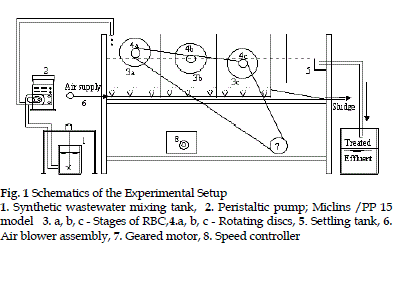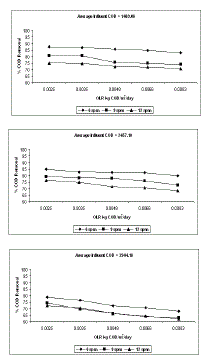Keywords
|
| RBC, Synthetic Sugar and Dairy effluent, COD, Discs. |
INTRODUCTION
|
| The biological, aerobic treatment processes have the known advantage of higher rate of COD removal to meet the treated effluent Standards for Disposal. RBC has such an exclusive advantage to offer effective treatment to high COD, biodegradable industrial waste streams. |
| Rotating Biological Contactors (RBC) is a unique, aerobic biochemical treatment process that can treat, invariably, all biodegradable waste streams. The inherent advantages of having attached growth in moving bed and suspended growth systems of micro organisms enable the RBC to perform as the most effective aerobic process to treat high COD industrial waste streams. |
| While aeration is used to supplement the activities of aerobic micro organisms with enhanced reactor volume, the system efficiency is found to get enhanced in removing the COD much effectively. |
| The effect of organic loading rate in the performance of RBC for treating sugar and dairy industrial waste streams are evaluated with an elaborate, experimental study. |
EXPERIMENTAL SETUP
|
| The experimental model is envisaged as modified RBC with increased reactor volume in each stage and with enhanced depth to support suspended growth system of microorganisms. The model is also incorporated with supplemental air supply to activate the aerobic biomass, both in suspended and attached growth systems. |
| The laboratory model of RBC has 10.125 litres effective volume, having three stages of rotating discs and a clarifier system as fourth stage, in series. |
| The three stages of RBC have equal number of rotating discs, numbering 15, each with a diameter of 0.1 m. The effective surface area, offered by the discs with their affixed modular plastic sheets, is estimated for 0.2368 m2. The clarifier system is having 0.0225 Sqm. as its over flow area. The three stages of RBC are supplied with air through a mini-aqua blower at 6 L/minute. |
| The discs are placed at different depth of submergences viz., 60, 50 and 40% respectively for I, II and III stages of RBC. |
| The rotation of the discs is systemized with geared motor and pulley arrangement to vary the rotational speed viz. 6, 9 and 12 rpm. |
| A peristaltic pump is used to regulate the influent flow rate and sustain the model for hydraulic stability. The schematic of the experimental model is presented in Fig. 1. |
EXPERIMENTAL METHODOLOGY
|
| The experiment was run using synthetic preparation of Sugar and Dairy effluent streams. The real time Sugar effluent was sampled from M/s. Rajashri Sugar Mills, Mundiyampakkam. The characteristics are simulated to prepare synthetic sugar effluent. The real time Dairy effluent samples were sampled from M/s. Hatsun Agro Industries Limited, Salem. The characteristics are simulated to prepare synthetic Dairy effluent. |
| The experiment was conducted for three different influent flow rates, for varying influent COD and varying rotational speed of discs. The synthetic sugar effluent is experimented for varying influent COD (1494.48, 2445.96 and 4008.61 mg/L), varying influent flow rate (0.0094, 0.0126, 0.0188, 0.0251 and 0.0314 m3/hr) and varying rotational speed of discs (6, 9 and 12 rpm). |
| The synthetic dairy effluent is experimented for varying influent COD (1489.08, 2457.10 and 3944.18 mg/L), varying influent flow rate (0.0094, 0.0126, 0.0188, 0.0251 and 0.0314 m3/hr) and varying rotational speed of discs (6, 9 and 12 rpm). |
RESULTS AND DISCUSSION
|
| The % COD removal efficiency for treating sugar effluent under varying organic loading rates for different rotational speeds of discs are presented in Fig. 2. |
| The % COD removal efficiency for treating dairy effluent under varying organic loading rates for different rotational speeds of discs are presented in Fig. 3. |
| The COD removal efficiency is observed for 72.93% to 91.66% for varying organic loading rates of 0.0025 to 0.0083 kg COD/m2/day, in the case of sugar effluent. The maximum efficiency of 91.66% for the OLR of 0.0025 kg COD/ m2/day was observed when the disc rotational speed is 6 rpm. |
| The COD removal efficiency is observed for 67.95% to 87.57% for varying organic loading rates of 0.0025 to 0.0083 kg COD/m2/day, in the case of dairy effluent. The maximum efficiency of 87.57% for OLR of 0.0023 kg COD/m2/ day was observed when the disc rotational speed is 6 rpm. |
CONCLUSION
|
| The RBC is found to offer the maximum COD removal of 91.66% for an Organic Loading Rate of 0.0039 kg COD/m2/day while the rotating disc speed is 6 rpm, for treating sugar effluent. |
| The RBC is found to offer the maximum COD removal of 87.57% for an Organic Loading Rate of 0.0023 kg COD/m2/day while the rotating disc speed is 6 rpm, for treating dairy effluent. |
| The rotational speed of discs is found to influence the % COD removal efficiency and 6 rpm is found to offer the maximum performance. Any increase in rotational speed is found to decrease the performance of the system. |
ACKNOWLEDGEMENT
|
| The authors acknowledge the authorities of Annamalai University for having permitted to carryout the research in the facilities of the University. |
Tables at a glance
|
Figures at a glance
|
 |
 |
 |
| Figure 1 |
Figure 2 |
Figure 3 |
|
| |
References
|
- Weng, C. 1972. Biological fixed film rotating disc for wastewater treatment, Ph.D. thesis, School of Engineering and Science, New York University .
- Watanable, Y., Iswaski, Y. and Masuda, S. 1983. Pilot plant study of an upgraded rotating biological contactor. Water Science and Technology.
- Nehru Kumar, V. 2000. Modified RBC for the Treatment of Sugar and Dairy Wastewater, Ph.D, Thesis, Annamalai University.
- Karthikeyan, C. 2001. Ph.D thesis titled Cassava starch waste water treatment in batch and Up-flow anaerobic sludge blanket reactors. Submitted to Annamalai University.
- Metcalf and Eddy, 2003. INC, Wastewater Engineering Treatment and Reuse. Tata Mc- Graw-Hill Publishing Company Ltd., New Delhi Fourth Edition .
- Salvado, H., Palomo, A., Mas, M., Puifagut, J. and Gracia, M.P. 2004. Dynamics of nematodes in high organic loading rotating biological contactors. Water Research. 38 : 2571-2578.
|